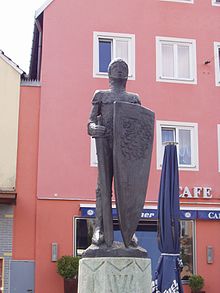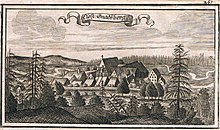Johann (Palatinate-Neumarkt)
Johann von Pfalz-Neumarkt , also Johann, the Upper Palatinate and Johann, the Hussite scourge (* 1383 in Neunburg vorm Wald , † March 14, 1443 in Kastl (in Lauterachtal) ) was Count Palatine and Duke in Bavaria . He founded the Wittelsbach line Pfalz-Neumarkt .
Life
Johann von Pfalz-Neumarkt was the son of the Rhenish elector Rupprecht III. , who was also the Roman-German king from 1400 to 1410, with his wife Elisabeth von Hohenzollern-Nuremberg . Rupprecht III. was the owner of the territories of the Electoral Palatinate , to which today's Upper Palatinate belonged , since 1329 through Wittelsbach's bisection of the Nordgau .
Johann married name in 1407 in Copenhagen with Catherine of Pomerania-Stolp , sister of the Nordic Union King Eric of Pomerania . However, she only married him on the condition that he had to build a Brigitten monastery in the Upper Palatinate, which then happened when the Gnadenberg monastery was founded. Katharina brought a dowry of 40,000 guilders into the marriage, for which Johann gave her the Heinzburg as a widow's property in the event of his death .
Johann, the second eldest son of Rupprecht III, became governor in the Upper Palatinate in 1404; this newly created dignity ("Duke in Bavaria") is perhaps related to the fact that Johann was initially striving to marry the daughter of the French king Michelle de Valois and that he had to be appropriately equipped for this; but this marriage did not materialize. Even as governor, Johann was quite confident, he waged a war against Bohemia , in which he took over from King Wenzel in 1405 Bärnau . After the death of his father in 1410, the Electoral Palatinate was divided between his four sons. Johann, received parts of today's Upper Palatinate (Upper Palatinate), but without Amberg and the Kurpräzipium , which he had both previously held. In addition to Neunburg vorm Wald, Johann chose Neumarkt in der Oberpfalz as his new residence town, where he arranged for the construction of a castle and several churches. The transfer of his court to Neumarkt led to a glamorous era for this city. In addition to art and culture, business, trade and construction flourished in the new seat of government. However, the administration of its Upper Palatinate territory also required a presence in other cities, above all in Sulzbach-Rosenberg and Neunburg vorm Wald .
The reign of Count Palatine Johann von Wittelsbach was marked by the support of King Sigismund I , his father's successor as King. However, Johann persistently tried to expand his territory in the direction of the Künisches Gebirge , which led to conflicts with his brother Ludwig III. (Palatinate) , who ruled other parts of the Upper Palatinate from Amberg . In 1415 he joined the nobility group of the Parakeet Society , directed against Ludwig VII (Bavaria) , of which he remained a member even after the conversion to the Konstanz League .
After the death of his brother Ludwig († 1436) he was able to fend off the claims of his younger brother Otto , who had received the guardianship of the still underage Ludwig IV , insofar as he opposed the waiver of the Electoral Palatinate parts of the Upper Palatinate with the Kurpräzipuum Swapped rights in the Electoral Palatinate . As a result, he had the entire Upper Palatinate in his hands from 1437 to 1442, but had to give up these parts again after Ludwig IV came of age.
Through contacts with the Hohenzollern in Nuremberg and Ansbach , he succeeded in becoming a member of the Danish Imperial Council for a while. This meant that his son Christoph von Pfalz-Neumarkt, born in 1416, was named Christoph III. (Denmark, Norway and Sweden) was later crowned King of Denmark, Sweden and Norway and ruled from Helsingborg from almost all of Northern Europe until his death in 1448 . For the duration of his absence he was represented by the knights Martin von Wildenstein and Hans von Parsberg. From 1447 he handed over the government to his uncle Count Palatine Otto von Pfalz-Mosbach. With the death of the 32-year-old Christoph, the Pfalz-Neunburg-Neumarkt line died out.
Johann married a second time after the death of his wife Katharina in 1428. This marriage with Beatrix von Bayern-Munich remained childless. On March 14, 1443 Johann died in the monastery castle at Kastl . He was buried in Neunburg vorm Wald in the castle church of St. Georg . Palatine was buried under a simple red marble grave slab. This was destroyed in 1965 during an incomprehensible renovation of the church and is only preserved in fragments.
The builder
During Johann's reign, the St. John's Church , the Hofkirche (1418) and the town hall (around 1410) were built in Neumarkt in der Oberpfalz in addition to the Palatine Palace. He had Haimburg , north of Neumarkt, converted into a hunting lodge and in Gnadenberg, at the request of his wife, he founded the Gnadenberg Monastery , the first brigade monastery in southern Germany. Not all buildings from that time have been preserved. The Count Palatine Castle, which was previously built in Gothic style, fell victim to a fire in 1520 and was only rebuilt in Renaissance style in 1539 by Count Palatine Friedrich II . The Haimburg and Gnadenberg Monastery are only preserved today as ruins.
In his second royal seat, Neunburg vorm Wald, he built a palace here in 1411 , after his grandfather Ruprecht II raised Neunburg to a palace in 1353 for the first time. There is a plaque on the castle with the following inscription:
"From 1410-1443, the court of Johann von Wittelsbach, Count Palatine of Neunburg-Neumarkt, the son of the German King Ruprecht, called the Hussite hostage, Neunburg's greatest benefactor, liked to hold this castle."
Against the Hussite incursions, Johann had the city of Neunburg fortified with a curtain wall, seven towers and a kennel. The Hussite invasion of 1418 failed on this fortress. Between the castle and the city, Johannes had a town hall built over the neck ditch between 1410 and 1415 .
The Hussite Scourge
Johann von Pfalz-Neumarkt had a dispute with the King of Bohemia in the Chodian settlement area over legal and property issues in today's border area between Bavaria and the Czech Republic . When the Czech Church scholar and reformer Jan Hus on July 6, 1415 for his religious beliefs in Konstanz to death by fire suffered, broke into Bohemia and Moravia in the 15th century Hussite Wars against the Roman Catholic church. The looting and devastation of monasteries and cities also spread to the neighboring Upper Palatinate.
By a resolution of the Reichstag, Johann was made Supreme Captain of the daily war against the Hussites in Bavaria in May 1426 . For this he should have 1000 mounted men available.
After 1419 Johann von Pfalz-Neumarkt marched with an army of crusaders against the army groups of the Taborites . He was able to put a stop to them in 1422 with the relief of Bischofteinitz , on September 11, 1426 near Klattau , 1429 near Neunburg vorm Wald and 1427 near Bärnau , as their general Andreas Prokop the Great on August 4, 1427 in the battle of Mies an army of the crusaders had defeated and army groups of the Hussites advanced to Bärnau near Tirschenreuth . In 1429 he was able to defeat 300 Hussite horsemen in Höll near Waldmünchen . On September 14, 1432 he succeeded in recapturing Reichenstein Castle . On September 21, 1433, Johann von Pfalz-Neumarkt defeated one of their armies in the Battle of Hiltersried . In 1434 he was involved in breaking the siege ring in front of Pilsen in order to regain the city. However, he had to buy peace in partial peace agreements by paying tributes to the Hussites (1418, 1420, 1430), which accordingly increased his permanent financial need.
His work against the attacks of the Hussites on the Upper Palatinate brought Palatine Johann von Pfalz-Neumarkt the nickname the Hussite scourge or the Hussite hammer in Bavarian historiography . After the lost battle near Taus on August 14, 1431, he farsightedly campaigned for a compromise peace with the Hussites and the Kingdom of Bohemia.
progeny
His first marriage was to Katharina von Pommern-Stolp (* 1390; † 1426), a daughter of Duke Wartislaw VII. († 1395). The marriage had seven children, six of whom died in childhood:
- Margaretha von Pfalz-Neumarkt (* 1408; † at a young age)
- Adolf von Pfalz-Neumarkt (* 1409; † 1409)
- Otto von Pfalz-Neumarkt (* 1410; † at a young age)
- Johann II of Pfalz-Neumarkt (* 1411; † at a young age)
- Friedrich von Pfalz-Neumarkt (* 1412; † at a young age)
- Johann III. von Pfalz-Neumarkt (* September 1413; † 3 days later)
- Christoph von Pfalz-Neumarkt (born February 26, 1416 - † January 5, 1448)
After the death of his first wife, he had been childless since 1428 with Princess Beatrix of Bavaria (1403–1447) , widow of Count Hermann III. of Cilli and the daughter of Duke Ernst from the Bayern-Munich line .
Aftermath
The Castle Festival of the Hussenkrieg in Neunburg vorm Wald is a reminder of the Hussite Wars, especially the victory in the Battle of Hiltersried . The Bundeswehr barracks Pfalzgraf-Johann-Kaserne , which was closed in June 2007, bore his name. Johann von Pfalz-Neumarkt is the namesake of the Neumarkt scouts of the DPSG ( German Scouts Saint Georg ).
literature
- Wilhelm Volkert : The Palatine branch lines since the 15th century . In: Andreas Kraus (Ed.): Handbook of Bavarian History . 3. Edition. tape III / 3 . CH Beck, Munich 1995, ISBN 3-406-39453-1 , p. 111-124, especially pp. 111-114 .
- Theo men: Count Palatine Johann . In: Hans Fischer, Manfred Kindler, Theo Männer, Peter Pauly, Otto Reimer, Rudolf Wisneth (eds.): Festschrift for the year of the Pfalzgraf-Johann year 1983 . Schmiedl, Neunburg vorm Wald 1983, pp. 19–45.
Web links
- Website of the Hussenkrieg Festival in Neunburg vorm Wald with a historical overview
- DPSG Neumarkt Stamm Pfalzgraf Johann with biography
- Mittelalterfreunde Neumarkt eV - Association that deals with the time of Count Palatine Johann, historical summary
Individual evidence
- ^ Dominik Dorfner: Hussites. From the stake in Constance to the fire sites in the Upper Palatinate. Accompanying volume for the exhibition in the pilgrimage museum Neukirchen b. Holy Blood and in the Schwarzachtaler Heimatmuseum Neunburg v. Forest . Pilgrimage Museum, Neukirchen b. Hl. Blut 1998, p. 42.
- ^ Dominik Dorfner: Hussites. From the stake in Constance to the fire sites in the Upper Palatinate. Accompanying volume for the exhibition in the pilgrimage museum Neukirchen b. Holy Blood and in the Schwarzachtaler Heimatmuseum Neunburg v. Forest . Pilgrimage Museum, Neukirchen b. Hl. Blut 1998, p. 40.
| personal data | |
|---|---|
| SURNAME | Johann |
| ALTERNATIVE NAMES | Johann von Pfalz-Neumarkt |
| BRIEF DESCRIPTION | Count Palatine and Duke in Bavaria |
| DATE OF BIRTH | 1383 |
| PLACE OF BIRTH | Neunburg vorm Wald |
| DATE OF DEATH | March 14, 1443 |
| Place of death | Kastl |


